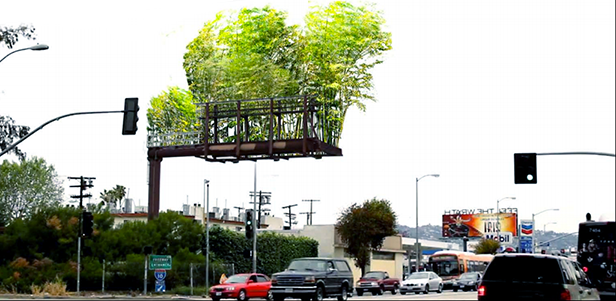The pros
Urban forests, in general, are a critically important to cooling the urban heat island effect, a phenomenon that Build It Smart explains impacts metropolitan areas. These environments experience greater temperatures due to the concentration of heat-producing, heat-retaining buildings, pavement, and traffic. Trees help to reduce the number of unhealthy smog alerts that occur during the summer months. And LEAF has this handy illustration to highlight the other benefits of getting the right trees in the right places. Theoretically these mounted bamboo forests should offer the same value, contributing to ozone protection while benefiting the health of urban dwellers and increasing overall quality of life.
According to the USDA Guide, "Businesses flourish, people linger and shop longer, apartments and office space rent quicker, tenants stay longer, property values increase, new business and industry is attracted" simply by trees. Though Urban Air billboards come at a cost, governments might be persuaded to capitalize on these economic benefits, in turn helping to finance projects such as these on an ongoing basis.
It's also possible that this project could contribute to other creative projects, igniting real change. With ongoing efforts to integrate green spaces into urban life through cost-effective, arguably more traditional methods – urban planning, city gardens – perhaps these billboards will serve to re-enforce the importance and beauty of urban forests. People may feel inspired to integrate green or environmental elements into other non-traditional spaces, serving to re-connect dwellers to nature.

The cons
The project bills itself as environmentally sustainable, yet remains financially questionable. Were Glassman to obtain the $100,000 in pledges required to secure funding, the combined costs of the billboard space, the embedded technology, the execution, and any incidentals may limit the number of billboards produced as well as their life expectancy. While the website doesn't note the maintenance costs of such an endeavour, I can't help but question the long-term economic viability. What if investors were to discontinue funding? That said, it's worth noting that to plant a single tree in Toronto can cost upwards of $500 - $750, and the costs to re-naturalize city spaces can really add up. If the benefits outweighed the costs, it's possible that governments could assume some of these costs given their value to the economy.
Bamboo trees are exceptionally sturdy. However, how would they respond to repeated exposure to storms and inclimate weather at such high elevations? Would proper controls need to be introduced to keep them from becoming invasive and aggressive in their new environments? And how would these bamboo trees fare in cities such as Toronto, where temperatures dip occasionally below -20? It would be interesting to hear how Glassman intends on combating these issues and what measures he might take to protect both the project and the city landscape and citizens.
Personally, I'm all for integrating more green space into urban life. I first heard about it reading Susmita Baral’s post on Greener Ideals. Not only is the idea visually appealing, but it offers a refreshing change of scenery from all of the concrete and construction we've grown accustomed to. I like living in a neighbourhood that successfully blends the best of city life -- close proximity to great restaurants and coffee jobs, grocery stores, a public library branch -- with classic residential markers, like old trees, parks and gardens. It'd be great to bring some of these elements closer to the downtown core. What do you think? How would you feel about transforming some of Toronto’s billboards into urban forests?
Sarah Berneche is a contributing writer and editor for LEAF. She has a B.A. and M.A. in English Language, Literature and Creative Writing from the University of Windsor, and attended Humber College's Creative Book Publishing post-graduate programme, where she specialized in editing and marketing. Sarah works, writes, cooks, and loves in Toronto. Follow her on twitter @sarahberneche.
